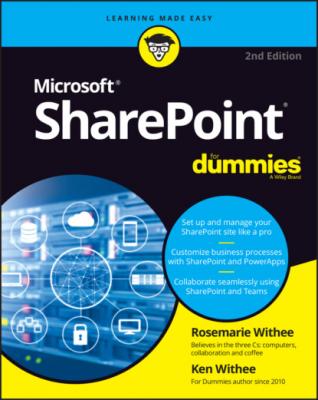SharePoint For Dummies. Rosemarie Withee
Чтение книги онлайн.
Читать онлайн книгу SharePoint For Dummies - Rosemarie Withee страница 16
 to know what the user can access.
to know what the user can access.
Microsoft has made great strides in simplifying identity management. SharePoint uses claims-based authentication in conjunction with an open authentication standard called Open Authorization (OAuth for short) in order to play nicely with other systems. What this means for you is that you shouldn’t have to remember yet another username and password when working with SharePoint. If only the rest of the Internet could be so thoughtful!
Mobile
The computing world has become mobile. People are more likely to have their computing device be their phone and tablet than any other type of computer. Microsoft recognized this and created the SharePoint Mobile App and also created a tool called PowerApps that allows you to create mobile SharePoint apps without needing to be a programmer. We cover the SharePoint Mobile App throughout the book and we cover PowerApps in Chapter 17.
Records management and compliance
In the world of information work, you often hear about records management and compliance. Depending on how much of a rebel you are, you might think of these terms as keeping people and processes in line or as an invitation to break some rules.
Every organization has a different set of rules around managing records and keeping processes compliant with company policy. This line of thinking is not specific to SharePoint, and, depending on your organization and industry, could be buttoned-up strict, as in the banking industry, or open to the world and free loving, as in many technology startup companies.
In SharePoint, a number of features are specifically designed to keep records organized and easily managed. In addition, SharePoint has compliance features that even the stodgiest of stodgy big banks will adore. And as someone who has done consulting work for the banking industry, let me tell you, there are some really strict compliance rules out there. (Considering that they’re keeping track of our money, that’s a good thing.)
Search
If you have ever used Google, Bing, or Duckduckgo.com, then you’re familiar with search engines. These search engines for the Internet are amazingly powerful and eerily comprehensive. SharePoint does a bang-up job of managing content, and the next logical step in managing content is finding content when you need it. As an organization grows, the need for search grows too. Search is covered in more detail in Chapter 23.
Social
In recent years, computers and the Internet have been connecting people like never before. This new way of interacting through computers is called social computing. The biggest public social network of all is Facebook. Not every organization wants to be in such a public space though.
SharePoint is designed for organizations, and the social aspects of SharePoint share a common goal with Facebook — connecting people. The difference is that SharePoint connections are limited to people within a particular organization. The social aspects of SharePoint are covered in Chapter 10.
Web content management
Content is a fairly simple concept. When you create a Word document or an Excel spreadsheet, you generate content. If you develop a web page for your colleagues to admire, you generate content. Even if you just pull out a pencil and paper and start writing, that’s content. If you scanned that paper, you could then let SharePoint work its content management wonders on the scanned image file.
SharePoint is especially powerful in handling content, as described in Part 5. One particularly tricky piece of content, however, is the content you develop for websites. You know, all of those web pages that contain policies and procedures and documentation and all of that? If the content is created for a web page, then it’s web content and it holds a special place in the heart of SharePoint. The web content management features of SharePoint are legendary, and many organizations first started using SharePoint for just this reason.
SharePoint and web content have a special relationship that all comes down to delegation and control. SharePoint provides the ability for many people to generate content and for a few people to approve content. This maintains order because a select group of people control what goes out to the world. SharePoint streamlines this process by allowing approved content to be published automatically.
You might be wondering what makes the relationship between SharePoint and web content so special. Well, it all comes down to delegation and control. SharePoint provides the ability for many people to generate content and for a few to approve content. After it’s approved, content can be published automatically to be consumed by the world or those in your organization.
Workflow
Workflow is one of those things in business that happens whether anyone wants it or not. If more than one person is required to achieve a goal, then a workflow is involved. SharePoint has been good in the past at handling workflow within SharePoint, but it lacked integration with other products. To address this deficiency, Microsoft created a new product called Microsoft Flow. Microsoft Flow is not part of SharePoint, but it integrates with SharePoint as well as with many, many other products (both Microsoft and others).
Using Microsoft Flow you can finally build a workflow that mimics the way you work. If you use products such as Survey Monkey, GitHub, Twitter, or many others, you can use Microsoft Flow to build workflows that integrate with SharePoint. We cover using Microsoft Flow with SharePoint in Chapter 15.
Chapter 2
Introducing SharePoint in Microsoft 365
IN THIS CHAPTER